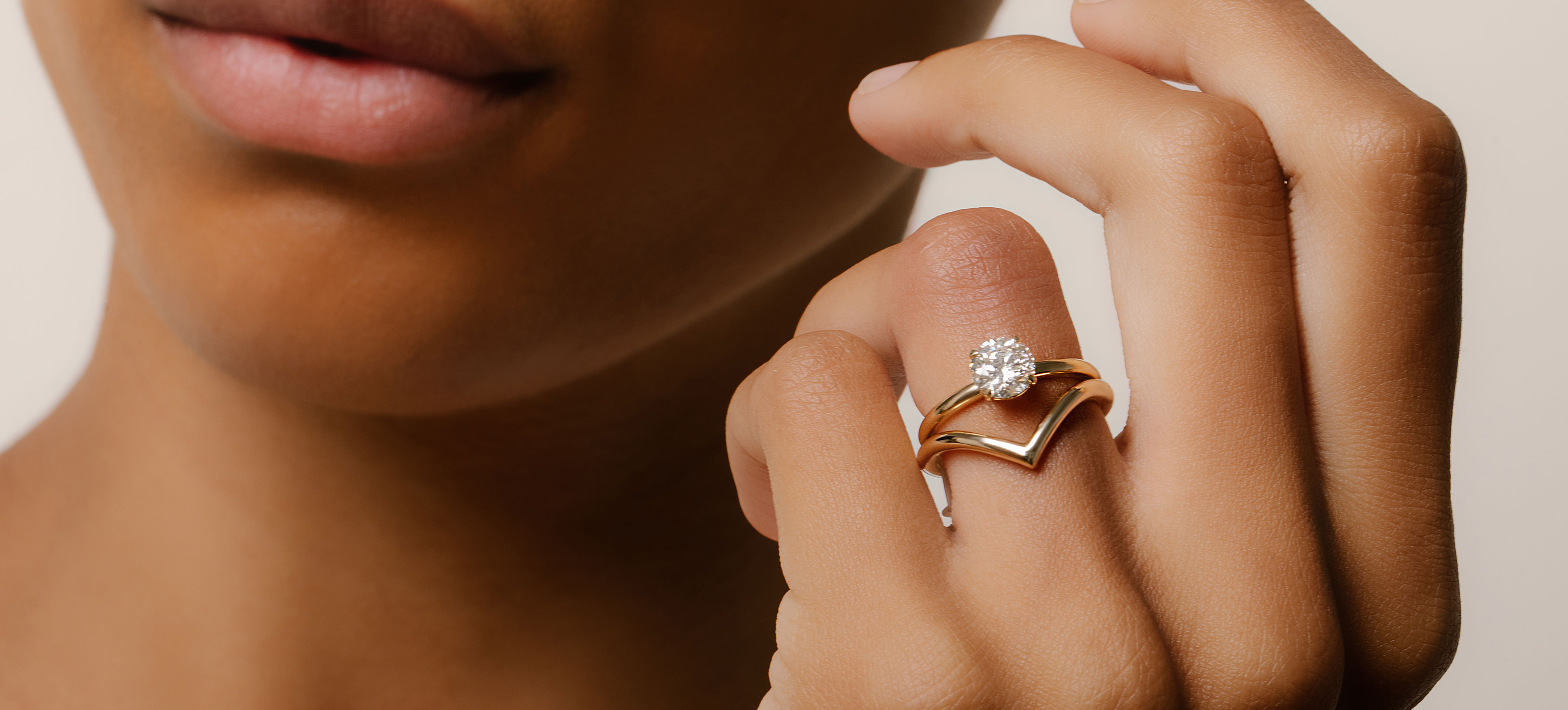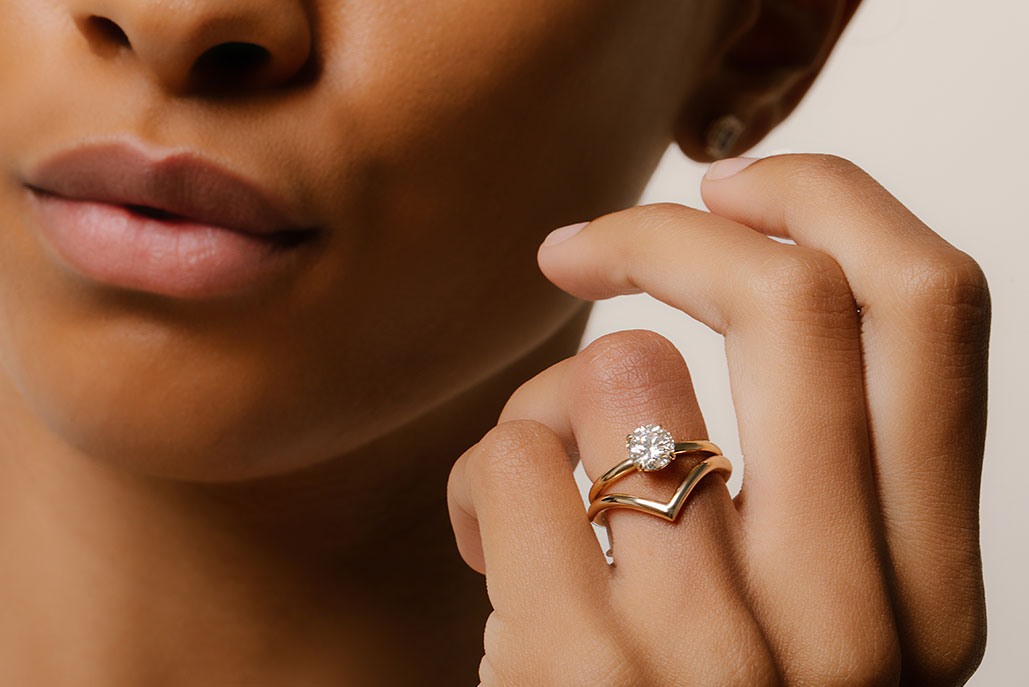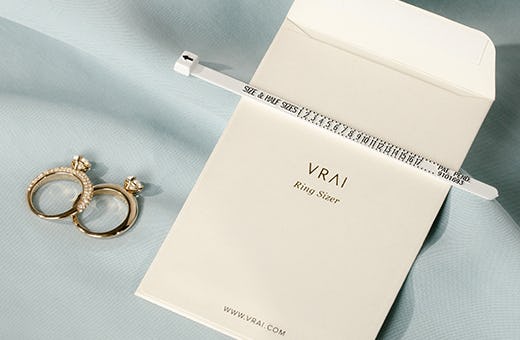

What Is the Diamond Color Scale?
The diamond color scale measures a diamond’s color grade. Starting from D, meaning colorless, the scale goes the alphabet all the way to Z. D through J diamonds are considered colorless or near colorless, and will appear clear on the scale. But anything beyond J will have slight hints of pale color begin to appear.
The diamond color scale starts with D because of the nearly-universally accepted standards set by the Gemological Institute of America (GIA). Before the GIA set these standards, some gemologists would give diamonds the color grades A, B, and C or the numbers 1-10. When the GIA began to enforce stricter standards of diamond grading, they started their scale at D to eradicate any confusion.
What Is Diamond Color?
Diamond color actually refers to the absence of color. It helps determine a diamond’s beauty, quality, and value.
Gemologists grade a diamond on the absence or presence of color to give each diamond a letter grade that corresponds with the color scale — from D, a truly colorless diamond, to Z, which is brown. The closer to colorless a diamond is, the rarer and more valuable it becomes.
While diamonds can come in a variety of colors, such as white, yellow, and pink, diamond color grades are what is listed on a diamond certificate, not the physical color of a diamond.
Why Is The Diamond Color Scale Important?
When you make the decision to buy an engagement ring, selecting the perfect center stone can be both exciting and overwhelming. That’s because choosing your favorite diamond shape is only the beginning. Understanding the 4Cs - cut, color, clarity, and carat - is essential when buying a diamond. Color — the second “C” — will have a major impact on the overall beauty and value of your center stone. Familiarizing yourself with the diamond color scale will help you determine which diamond is meant just for you.


Be the first to know
Hear about our latest designs and upcoming events.


Diamond Color Grading And The Diamond Color Chart
Most gemologists grade a diamond’s color by comparing it to other diamonds with an established color value. They inspect the stones under controlled lighting and viewing conditions. Because most diamond color variations are invisible to the naked eye, gemologists might also use specific tools, like a dichroscope, to complete their evaluation.
A diamond is inspected both face-up and table-down for traces of color. Even the faintest hint in one of these areas will affect its color grade.
Below you’ll find each diamond color grade, from highest to lowest. While the diamond color scale goes to Z, any diamond with a color grade below M is not considered jewelry grade.


Colorless Diamonds
Colorless diamonds have a color grade of D, E, or F — the highest color quality available. D-F diamonds do not have any color that's visible to the eye. They are ideal for any white gold and platinum engagement ring or jewelry design that won’t further imbue them with color.
D Color Grade Diamonds
D is the highest color grade. A D diamond has nearly no color and is colorless both when viewed with the naked eye and inspected under magnification.
E Color Grade Diamonds
E is the second highest color grade and is considered colorless. The difference between D and E might be a tiny trace of color that is only visible under magnification.
F Color Grade Diamonds
F color diamonds are at the bottom of the colorless range of diamonds, but still appear colorless to the naked eye. What differentiates them from D and E is that they have a slight tint only visible under magnification.
Near Colorless Diamonds
Near colorless diamonds are of the colors G, H, I, and J. Near colorless diamonds are diamonds that, when face up, still appear "colorless.” Most cannot tell the difference between the two categories without comparing them side by side against a white background.
G Color Grade Diamonds
G is the top color grade in the near-colorless range. Most consumers do not see their slight traces of color, but trained gemologists can see their tint. G diamonds are an excellent choice for those wanting a diamond that appears colorless, but at a slightly lower price.
H Color Grade Diamonds
H is a near-colorless diamond, with only a few differences that set it apart from a G. As most consumers cannot see the hints of color in an H color grade diamond, they are an excellent choice for those wanting to save money while still investing in what appears to be a colorless diamond.
I Color Grade Diamonds
I is nearing the bottom of the near-colorless range. Like G and H, it will appear virtually colorless to most, but gemologists can see its traces of color during testing. I is ideal for those wanting a diamond close to colorless but at a much more accessible price point.
J Color Grade Diamonds
J is at the very bottom of the near-colorless range and is the last grade before color becomes visible to the naked eye. J color diamonds are likely the most affordable diamonds that still appear virtually colorless to most consumers.
Faintly Colored Diamonds
Faintly colored diamonds are diamonds whose trace amounts of yellow are visible to the naked eye. Most jewelry brands will only sell K color grade diamonds from the faintly colored range. They have a yellow tint that can be masked in a solid yellow gold setting.
K Color Grade Diamonds
K is the top of the faintly-colored scale and is known for having a hint of yellow that’s noticeable to the naked eye. A K color grade diamond should most likely be featured in yellow or even rose gold settings to mask its traces of yellow.
L Color Grade Diamonds
L color grade diamonds have a yellow tint that is visible to the naked eye. This color is usually visible from the side. Many jewelers, including VRAI, do not sell L color grade diamonds.
M Color Grade Diamonds
M color grade diamonds are exactly in the middle of the color scale. They have a noticeable tint that is best seen from the side. Many jewelers, including VRAI, do not sell M color grade diamonds.
| Diamond Color Grade | Diamond Color Category | Description |
|---|---|---|
| D | Colorless | D is the highest color grade. D diamonds show no color when viewed with the naked eye and under magnification. |
| E | Colorless | The difference between D and E is only visible under magnification. |
| F | Colorless | F color diamonds still appear colorless to the naked eye. Only visible under magnification |
| G | Near Colorless | Most consumers will not see their slight color traces in G diamonds. Gemologists can see their tint under inspection. |
| H | Near Colorless | Most consumers will not notice the hints of color or notice the difference btween G and H. |
| I | Near Colorless | I color diamonds will appear virtually colorless to most. Gemologists can see traces of color. |
| J | Near Colorless | J diamonds are the last grade before the naked eye can detect color tints. |
| K | Faintly Colored Diamonds | K diamonds show a hint of yellow that’s noticeable to the naked eye. |
| L | Faintly Colored Diamonds | L color grade diamonds have a yellow tint that is visible to the naked eye. |
| M | Faintly Colored Diamonds | M color grade diamonds have a noticeable tint that is best seen from the side. |
What Is The Best Diamond Color?
Colorless is the “best” or highest grade on the diamond color scale. D color grade diamonds are considered the rarest, or most valuable, diamond color grade. But remember that D color grade diamonds may not be the best personal choice when it comes to your very own engagement ring.
Diamond Color vs. Clarity
When it comes to the 4Cs, color and clarity can often be confused for one another. This is because both color and clarity affect a diamond’s general appearance. But where color measures the lack of color, clarity measures the lack of inclusions and blemishes.
For those wanting to prioritize one over the other, it’s best to speak with a diamond expert who can give you personalized guidance when selecting your stone. But generally, each one gains importance depending on the diamond shapes or even engagement ring settings.
Diamond Color: Frequently Asked Questions
Everything you need to know about the diamond color grading scale and finding the diamond color that’s right for you.
How Do I Choose The Best Diamond Color?
To find the best diamond color for you, start by setting a budget. Note that you must purchase both the setting and the diamond for an engagement ring, so budget for both. The higher a diamond is on the color scale, particularly D-F color graded diamonds, the higher the price. So decide together if you have flexibility when it comes to color or the other Cs.
Next, select your diamond shape and setting. These choices will directly affect what color grade you should select. Diamond shapes with a larger table, like a Marquise, often show more color than a Round Brilliant, for example. White gold or platinum settings will further highlight hints of yellow and are best paired with colorless diamonds.
Does Carat Weight Affect Diamond Color?
Carat size has a hand in how obvious a diamond’s color appears. The larger the diamond, the more evident color. If your diamond will be under a carat, you can get away with a lower color grade, but if you’re interested in a larger diamond, it’s recommended to invest in colorless or near colorless diamonds.
Does Shape Affect Diamond Color?
Certain diamond shapes will hide color better than others. The symmetry of Round Brilliant diamonds can allow you to save on color with a slightly lower grade. Emerald shapes tend to hide color as well and can tolerate a lower color grade. Shapes with larger face-up size, like the Oval, are inclined to show color more and are better suited for colorless or near colorless diamonds. The more unique shapes—Cushion, Pear, Marquise, Asscher, and Trillion—are also susceptible to showing more color.
Does Metal Affect Diamond Color?
The metal in which you set your diamond will have an effect on the perception of its color. Yellow gold can offset diamonds of a more yellow hue. Rose gold’s warmth, like yellow gold, can also balance out slight yellow tones. White gold or platinum can emphasize yellow coloring within a diamond — if choosing one of these two metals, consider prioritizing a higher color graded diamond for a more balanced design.
For those wanting to highlight their colorless diamond in a yellow or rose gold ring, a Two Tone engagement ring is ideal. The platinum prongs that hold the diamond in place won’t imbue the diamond with the same color from the ring’s band.
How Many Diamond Colors Are There?
For colorless diamonds, there are 23 diamond color grades, ranging from D to Z.
When it comes to all diamond colors, there are 12 base colors: red, yellow, orange, green, blue, pink, purple, brown, violet, gray, white, and black. These fancy colors have their own diamond color scales.
Does Diamond Color Matter?
Diamond color is important when determining the quality of your diamond, and it will directly impact the price. Whether diamond color matters the most to you personally, however, is based on preference.
Most diamonds used in engagement rings are near-colorless with hints of yellow. Decide on what color grade range works best for your budget, diamond shape, and engagement ring setting.
Does Diamond Color Affect Price?
Diamond color will affect the overall price of a diamond. Generally, each color grade constitutes a 10% price difference.
Can Lab-Grown Diamonds Be Graded On Color?
Lab-grown diamonds can and should be graded. Lab-grown diamonds occur in different colors, just as their mined counterparts do. Color is determined when a diamond is formed, either in a laboratory setting or in the ground. Therefore, diamonds should go through a color grading process and be evaluated on the other 4Cs, no matter their origin.

Get your complimentary ring sizer!
Measure your ring size for the perfect fit right from the start.
Shop VRAI Created Diamonds With Our Diamond Experts
VRAI offers colorless, near colorless and faintly colored diamonds grown in our zero-emissions foundry. At this level, color differences are difficult to detect unless compared side-by-side.
The majority of VRAI created diamonds are primarily colorless or near colorless ranging from D-J on the color scale. For diamonds with eye-visible color grades, the extent of the visibility of the faint hue can be viewed through our 360 videos for each unique diamond, based on their shape and cut, or requested from our diamond specialists during appointments.
Book a complimentary appointment with our diamond experts to find the color grade that’s right for you. Through personalized guidance and in-depth diamond education, they will help you complete your engagement ring setting with the ideal VRAI created diamond.

